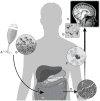Immune activation and neuroinflammation in alcohol use and HIV infection: evidence for shared mechanisms
- PMID: 27532935
- PMCID: PMC5250549
- DOI: 10.1080/00952990.2016.1211667
Immune activation and neuroinflammation in alcohol use and HIV infection: evidence for shared mechanisms
Abstract
Background: Emerging research points to innate immune mechanisms in the neuropathological and behavioral consequences of heavy alcohol use. Alcohol use is common among people living with HIV infection (PLWH), a chronic condition that carries its own set of long-term effects on brain and behavior. Notably, neurobiological and cognitive profiles associated with heavy alcohol use and HIV infection share several prominent features. This observation raises questions about interacting biological mechanisms as well as compounded impairment when HIV infection and heavy drinking co-occur.
Objective and method: This narrative overview discusses peer-reviewed research on specific immune mechanisms of alcohol that exhibit apparent potential to compound the neurobiological and psychiatric sequelae of HIV infection. These include microbial translocation, systemic immune activation, blood-brain barrier compromise, microglial activation, and neuroinflammation.
Results: Clinical and preclinical evidence supports overlapping mechanistic actions of HIV and alcohol use on peripheral and neural immune systems. In preclinical studies, innate immune signaling mediates many of the detrimental neurocognitive and behavioral effects of alcohol use. Neuropsychopharmacological research suggests potential for a feed-forward cycle in which heavy drinking induces innate immune signaling, which in turn stimulates subsequent alcohol use behavior.
Conclusion: Alcohol-induced immune activation and neuroinflammation are a serious health concern for PLWH. Future research to investigate specific immune effects of alcohol in the context of HIV infection has potential to identify novel targets for therapeutic intervention.
Keywords: Alcohol use disorder; HIV infection; behavioral neuroscience; inflammation; innate immune system; microbial translocation; neuroimaging.
Conflict of interest statement
Declaration of Interest: The author has no relevant financial disclosures or conflicts of interest.
Figures

Similar articles
-
HIV Infection, HCV Coinfection, and Alcohol Use: Associations with Microbial Translocation and Immune Activation.Alcohol Clin Exp Res. 2019 Jun;43(6):1126-1134. doi: 10.1111/acer.14032. Epub 2019 Apr 29. Alcohol Clin Exp Res. 2019. PMID: 30908642 Free PMC article.
-
Alcohol Use and Abuse Conspires With HIV Infection to Aggravate Intestinal Dysbiosis and Increase Microbial Translocation in People Living With HIV: A Review.Front Immunol. 2021 Dec 17;12:741658. doi: 10.3389/fimmu.2021.741658. eCollection 2021. Front Immunol. 2021. PMID: 34975838 Free PMC article. Review.
-
Effects of alcohol and HIV infection on the central nervous system.Alcohol Res Health. 2001;25(4):288-98. Alcohol Res Health. 2001. PMID: 11910707 Free PMC article. Review.
-
Markers of Microbial Translocation and Immune Activation Predict Cognitive Processing Speed in Heavy-Drinking Men Living with HIV.Microorganisms. 2017 Sep 21;5(4):64. doi: 10.3390/microorganisms5040064. Microorganisms. 2017. PMID: 28934108 Free PMC article.
-
Impact of the Innate Immune Response in the Actions of Ethanol on the Central Nervous System.Alcohol Clin Exp Res. 2016 Nov;40(11):2260-2270. doi: 10.1111/acer.13208. Epub 2016 Sep 21. Alcohol Clin Exp Res. 2016. PMID: 27650785 Review.
Cited by
-
Effects of Combination of Ethanol With Ritonavir, Lopinavir or Darunavir on Expression and Localization of the ER-Associated Set Protein and Infection of HIV-1 Pseudovirus in Primary Human Cells.J Acquir Immune Defic Syndr. 2024 Jun 1;96(2):e6-e10. doi: 10.1097/QAI.0000000000003411. J Acquir Immune Defic Syndr. 2024. PMID: 38771756 Free PMC article. No abstract available.
-
Problematic alcohol use among gay, bisexual, and other men who have sex with men in Canada: the role of proximal stressors and anxiety.Subst Abuse Treat Prev Policy. 2024 Feb 28;19(1):16. doi: 10.1186/s13011-024-00597-8. Subst Abuse Treat Prev Policy. 2024. PMID: 38414042 Free PMC article.
-
Potential Role of Extracellular CIRP in Alcohol-Induced Alzheimer's Disease.Mol Neurobiol. 2020 Dec;57(12):5000-5010. doi: 10.1007/s12035-020-02075-1. Epub 2020 Aug 21. Mol Neurobiol. 2020. PMID: 32827106 Free PMC article. Review.
-
Prenatal and adolescent alcohol exposure programs immunity across the lifespan: CNS-mediated regulation.Pharmacol Biochem Behav. 2022 May;216:173390. doi: 10.1016/j.pbb.2022.173390. Epub 2022 Apr 18. Pharmacol Biochem Behav. 2022. PMID: 35447157 Free PMC article. Review.
-
Role of Autophagy in HIV-1 and Drug Abuse-Mediated Neuroinflammaging.Viruses. 2022 Dec 23;15(1):44. doi: 10.3390/v15010044. Viruses. 2022. PMID: 36680084 Free PMC article. Review.
References
-
- Centers for Disease Control and Prevention. Behavioral and clinical characteristics of persons receiving medical care for HIV infection--Medical Monitoring Project, United States, 2010. 2014 - PubMed
Publication types
MeSH terms
Grants and funding
LinkOut - more resources
Full Text Sources
Other Literature Sources
Medical
